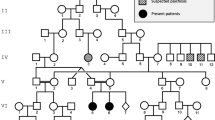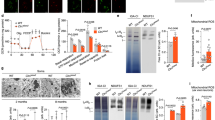Abstract
The storage of subunit c of mitochondrial ATP synthase, other hydrophobic peptides, and autofluorescent pigment in both late infantile (CLN2) and juvenile (CLN3) neuronal ceroid lipofuscinosis, but not in infantile (CLN1), has raised the question of abnormal mitochondrial function. We now report a partial deficiency in three types of fatty acid oxidation in intact skin fibroblasts from CLN2 and CLN3 patients, but not CLN1. We observed a statistically significant 33% reduction in palmitate (β-oxidation; mainly mitochondrial) and lignocerate (β-oxidation; mainly peroxisomal), and a 50% reduction in phytanic acid (α-oxidation; mainly peroxisomal) in the absence of exogenous carnitine. In contrast, when we measured fatty acid β-oxidation (lignoceric acid and palmitic acid), in the same human skin fibroblasts, following lysis in the presence of carnitine, we found no difference in enzyme activity among normal, CLN1, CLN2, and CLN3. However, we did observe a 40% reduction in peroxisomal particulate (bound) catalase activity in CLN1 and CLN2 fibroblasts, which typically results from organellar lipid accumulation or a membrane abnormality. However, total catalase levels were normal, and western blot analysis of this and three other major oxidant protective enzymes (Mn-dependent superoxide dismutase [MnSOD], CuZn-dependent superoxide dismutase [CuZnSOD], and glutathione peroxidase) were normal in CLN1, CLN2, and CLN3, as well as in liver from an animal (English Setter dog) model for CLN, which shows similar pathology and subunit c storage. Our data showing differences between CLN1 and forms CLN2 and CLN3 suggest some type of mitochondrial membrane abnormality as the source of the pathology in CLN2 and CLN3.
Similar content being viewed by others
References
Dawson G. and Glaser P. (1987) Apparent cathepsin B deficiency in neuronal ceroid lipofuscinosis can be explained by peroxide inhibition.Biochem. Biophys. Res. Commun. 147, 267–274.
Dawson G., Kilkus J., and Siakotos A. N. (1993) Reduced phospholipase activity, peptide storage and the pathogenesis of canine neuronal ceroid-lipofuscinosis.J. Inherited Metab. Dis. 16, 330–334.
Dawson G., Matalon R., and Dorfman A. (1972) Glycosphingolipids in culture human skin fibroblasts.J. Biol. Chem 244, 5944–5950.
Ezaki J., Wolfe L. S., Higuti T., Ishidoh K., and Kominami E. (1995) Specific delay of degradation of mitochondrial ATP synthase subunit c in late infantile ceroid lipofuscinosis (Batten Disease).J. Neurochem. 64, 733–741.
Hall N. A. and Patrick A. D. (1988) Accumulation of dolichol-linked oligosacharides in Ceroid lipofuscinosis.Am. J. Med. Genet. Suppl. 5, 222–232.
Ivy G. O., Schottler F., Wenzel J., Baudry M., and Lynch G. (1984) Inhibitors of lysosomal enzymes: Accumulation of lipofuscin dense bodies in brain.Science 226, 985–987.
Katz M. L. and Siakotos A. N. (1995) Canine hereditary Ceroid-Lipofuscinosis: Evidence for a defect in the carnitine biosynthetic pathway.Am. J. Med. Genet. 57, 266–271.
Katz M. L., Christianson J. S., Norbury N. E., Gao C. L., Siakotos A. N., and Koppang N. (1994) Lysine methylation of mitochondrial ATP synthase subunit c stored in tissues of dogs with hereditary ceroid lipofuscinosis.J. Biol. Chem. 269, 9906–9911.
Lenn N. J. and Dawson G. (1973) On the significance of curvilinear bodies in late infantile lipidosis.Am. J. Ment. Def. 77, 597–606.
Lerner T. J. et al. (1995) Isolation of a novel gene underlying Batten disease, CLN3.Cell 82, 949–957.
Majander A., Pihko H., and Santavuori P. (1995) Palmitate oxidation in muscle mitochondria of patients with the juvenile form of neuronal ceroid-lipofuscinosis.Am. J. Med. Genet. 57, 298–300.
Palmer D. N., Fearnley I. M., Walker J. E., Hall N. A., Lake B. D., Wolfe L. S., Haltia M., Martinus R. D., and Jolly R. D. (1992) Mitochondrial ATP synthase storage in the ceroidlipofuscinoses (Batten Disease).Am. J. Med. Genet. 42, 561–567.
Palmer D. N., Martius R. D., Cooper S. M., Midwinter G. G., Reid J. C., and Jolly R. D. (1989) Ovine ceroid lipofuscinosis. The major lipopigment and the lipid-binding subunit of mitochondrial ATP synthase have the same NH2-terminal sequence.J. Biol. Chem 264, 5736–5740.
Rider J. A., Dawson G., and Siakotos A. N. (1992) Perspectives of biochemical research in the neuronal ceroid lipofuscinoses.Amer. J. Med. Genet. 42, 519–524.
Siakotos A. N., Van Kuijk F. J. G. M., and Tischfield J. A. (1993) Elevated levels of neutrophil 4-hydroxynonenal in canine neuronal ceroid lipofuscinosis and human immortalized lymphocytes of NCL patients.J. Inherited Metab. Dis. 16, 323–329.
Singh I., Moser A. E., Goldfischer S., and Moser H. W. (1984) Lignoceric acid is oxidized in peroxisomes: Implications for Zellweger Cerebro-Hepato-Renal Syndrome and Adrenoleukodystrophy.Proc. Natl. Acad. Sci. USA 81, 4203–4207.
Singh I., Lazo O., Dhaunsi G. S., Contreras M. (1992) Transport of fatty acid into human peroxisomes: Differential transport of palmitic and lignoceric acids and its implications to X-Adrenoleukodystrophy.J. Biol. Chem. 267, 13,306–13,313.
Singh J., Pahan K., Dhaunsi K. S., Lazo O., and Ozand P. (1993) Phytanic acid α-oxidation: Differential subcellular localization in rat and human tissues and its inhibition by Nycodenz.J. Biol. Chem. 268, 9972–9979.
Towbin H., Straehelin T., and Gordon J. (1979). Electrophoretic transfer of proteins from polyacrylamide gels to nitrocellulose sheets: Procedure and some applications.Proc. Natl. Acad. Sci. USA 76, 4350–4354.
Tyynela J., Palmer D. N., Baumann M., and Haltia M. (1993) Storage of saposins A and D in infantile neuronal ceroid lipofuscinosis.FEBS Lett. 330, 8–12.
Vesa J et al. (1995) Mutations in the palmitoyl protein thioesterase gene causing infantile neuronal ceroid lipofuscinosis.Nature 376, 584–587.
Author information
Authors and Affiliations
Rights and permissions
About this article
Cite this article
Dawson, G., Kilkus, J., Siakotos, A.N. et al. Mitochondrial abnormalities in CLN2 and CLN3 forms of batten disease. Molecular and Chemical Neuropathology 29, 227–235 (1996). https://doi.org/10.1007/BF02815004
Received:
Revised:
Accepted:
Issue Date:
DOI: https://doi.org/10.1007/BF02815004




